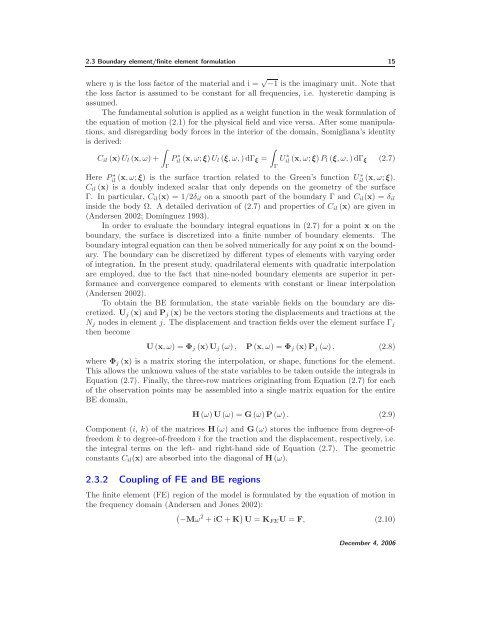Dynamic behaviour of suction caissons
Dynamic behaviour of suction caissons
Dynamic behaviour of suction caissons
Create successful ePaper yourself
Turn your PDF publications into a flip-book with our unique Google optimized e-Paper software.
2.3 Boundary element/finite element formulation 15<br />
where η is the loss factor <strong>of</strong> the material and i = √ −1 is the imaginary unit. Note that<br />
the loss factor is assumed to be constant for all frequencies, i.e. hysteretic damping is<br />
assumed.<br />
The fundamental solution is applied as a weight function in the weak formulation <strong>of</strong><br />
the equation <strong>of</strong> motion (2.1) for the physical field and vice versa. After some manipulations,<br />
and disregarding body forces in the interior <strong>of</strong> the domain, Somigliana’s identity<br />
is derived:<br />
∫<br />
∫<br />
C il (x) U l (x, ω) + Pil ∗ (x, ω; ξ)U l (ξ, ω, )dΓ ξ = Uil ∗ (x, ω; ξ)P l (ξ, ω, )dΓ ξ (2.7)<br />
Γ<br />
Γ<br />
Here Pil ∗ (x, ω; ξ) is the surface traction related to the Green’s function U il ∗ (x, ω; ξ).<br />
C il (x) is a doubly indexed scalar that only depends on the geometry <strong>of</strong> the surface<br />
Γ. In particular, C il (x) = 1/2δ il on a smooth part <strong>of</strong> the boundary Γ and C il (x) = δ il<br />
inside the body Ω. A detailed derivation <strong>of</strong> (2.7) and properties <strong>of</strong> C il (x) are given in<br />
(Andersen 2002; Domínguez 1993).<br />
In order to evaluate the boundary integral equations in (2.7) for a point x on the<br />
boundary, the surface is discretized into a finite number <strong>of</strong> boundary elements. The<br />
boundary integral equation can then be solved numerically for any point x on the boundary.<br />
The boundary can be discretized by different types <strong>of</strong> elements with varying order<br />
<strong>of</strong> integration. In the present study, quadrilateral elements with quadratic interpolation<br />
are employed, due to the fact that nine-noded boundary elements are superior in performance<br />
and convergence compared to elements with constant or linear interpolation<br />
(Andersen 2002).<br />
To obtain the BE formulation, the state variable fields on the boundary are discretized.<br />
U j (x) and P j (x) be the vectors storing the displacements and tractions at the<br />
N j nodes in element j. The displacement and traction fields over the element surface Γ j<br />
then become<br />
U(x, ω) = Φ j (x)U j (ω), P(x, ω) = Φ j (x)P j (ω), (2.8)<br />
where Φ j (x) is a matrix storing the interpolation, or shape, functions for the element.<br />
This allows the unknown values <strong>of</strong> the state variables to be taken outside the integrals in<br />
Equation (2.7). Finally, the three-row matrices originating from Equation (2.7) for each<br />
<strong>of</strong> the observation points may be assembled into a single matrix equation for the entire<br />
BE domain,<br />
H (ω)U(ω) = G (ω)P(ω). (2.9)<br />
Component (i, k) <strong>of</strong> the matrices H (ω) and G (ω) stores the influence from degree-<strong>of</strong>freedom<br />
k to degree-<strong>of</strong>-freedom i for the traction and the displacement, respectively, i.e.<br />
the integral terms on the left- and right-hand side <strong>of</strong> Equation (2.7). The geometric<br />
constants C il (x) are absorbed into the diagonal <strong>of</strong> H (ω).<br />
2.3.2 Coupling <strong>of</strong> FE and BE regions<br />
The finite element (FE) region <strong>of</strong> the model is formulated by the equation <strong>of</strong> motion in<br />
the frequency domain (Andersen and Jones 2002):<br />
(<br />
−Mω 2 + iC + K ) U = K FE U = F, (2.10)<br />
December 4, 2006

















